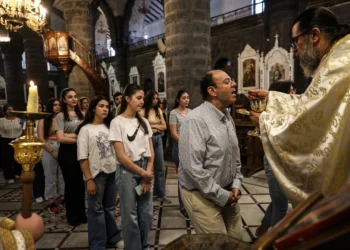Ceasefire-hostage negotiations that have exhausted the diplomatic character of the Israel–Hamas war reached a new stalemate this week. Hamas, feeling the pressure of the Israel Defense Force (IDF) approaching Gaza City, agreed on Sunday to a deal brokered by U.S. envoy Steve Witkoff and Qatari and Egyptian mediators. While the offer was being weighed in Jerusalem, Israeli Prime Minister Netanyahu’s government doubled down on its unconditional stance to see all hostages released in one go, while the security cabinet gave the green light for the IDF to move forward with the approved plan to conquer Gaza City.
According to the deal’s stipulations, one living Israeli is exchanged for 60 Palestinian security prisoners … and one dead Israeli body is exchanged for 10 bodies of dead Palestinian prisoners.
On Sunday, August 17, Hamas announced it had accepted the brokered deal that included a 60-day ceasefire to allow for the exchange of 10 living Israeli hostages and the bodies of 18 dead hostages, all abducted by Hamas on October 7, 2023, in exchange for the release of hundreds of Palestinian prisoners held by Israel. According to the deal’s stipulations, one living Israeli is exchanged for 60 Palestinian security prisoners serving more than 15-year sentences, and one dead Israeli body is exchanged for 10 bodies of dead Palestinian prisoners. (RELATED: Memo to All Demanding Palestinian Statehood: Hamas Still Has Hostages)
For months, Jerusalem had been leading and encouraging these types of “phased” or “partial” deals — ones that stipulate limited ceasefire periods and facilitate the partial exchange of hostages. These negotiations only work in Hamas’s favor. The disproportionate ratio of released Israeli hostages to Palestinian prisoners sees hundreds of convicted Palestinian terrorists released back into the West Bank and Gaza Strip. Furthermore, the partial exchange ensures that Hamas always retains Israeli hostages as leverage for future negotiations. These disadvantages don’t escape the Israeli consciousness, but Jerusalem nonetheless has been leading these negotiations over the past year under international and domestic pressure to see the hostages returned and end the war. (RELATED: So Let’s Say Israel Agrees to Full Withdrawal and All Hamas’s Demands)
The past week, however, saw a shift in Israel’s negotiating tone. Ever since the IDF commenced Operation Gideon’s Chariot in May, Israel’s war objective has been to seize and control areas of the Gaza Strip as a strategy to pressure Hamas to give up its military and political strongholds. Last week, Israel announced new plans to conquer Gaza City, the largest urban center in the strip and the heart of Hamas’s operations, where it is believed the remaining 50 Israeli hostages (20 to 22 of them believed to be alive) are held. This pressure, Netanyahu believes, is what forced Hamas to accept the Qatari and Egyptian-brokered deal last weekend. (RELATED: Israel Should Annex Land in Gaza, Judea and Samaria)
But while Jerusalem weighed the brokered deal earlier this week, Israeli media reported that anything short of a complete, unconditional return of all living and dead hostages and the full surrender of Hamas is off the table. According to Channel 12 in Israel, officials in Jerusalem feared that because of the extreme pressure from world leaders to quickly cut a deal and end the war, accepting last weekend’s proposal may lead to a permanent cessation and the withdrawal of security forces from the Gaza Strip while Israeli hostages and bodies are still held in Hamas captivity. (RELATED: The Arab League and Gaza)
Jerusalem’s conditions for ending the war are the disarmament of Hamas; the return of all hostages, living and dead; the dismantling of Hamas’s and other terrorist organization’s governing power; Israeli security in the Gaza Strip; and a new Palestinian government in place that is not Hamas or the Palestinian Authority — conditions that Hamas is not willing to accept.
“Israel demands the release of all 50 hostages in accordance with the principle set by the cabinet for ending the war. We are at the final stage of decisively defeating Hamas, and we will not leave any hostages behind,” a statement by senior Israeli officials stated.
Initially, top IDF officials were hesitant that expanding Operation Gideon’s Chariot into Gaza City would endanger the remaining living hostages, believed to be held captive there. But on Tuesday night, after officials in Jerusalem received notice of Hamas’s agreement to the Qatari-Egyptian deal, Defense Minister Israel Katz and his senior officers in the security cabinet gave the green light for the IDF to capture and hold all of Gaza City and the northern strip. The IDF has already called up an additional 60,000 reservists in preparation for the campaign. (RELATED: Gideon’s Chariots Opens New Gaza Offensive With Aid Concessions)
On Tuesday, the Israeli media outlet Kan 12 reported that Sunday’s brokered deal is no longer relevant. “We are now discussing only the capture of Gaza City,” Kan 12 stated, but noted that mediators are still working and that “following Hamas’s response, the chance of a deal in the Witkoff framework has increased.”
The new push to take Gaza City — as well as Gideon’s Chariot at large — has raised criticism from world leaders over how Israel’s military campaign will displace Gazan civilians and hinder the flow of humanitarian aid. Leaders from the U.N. and across the world have condemned Israel’s planned conquest of Gaza as illegal. French President Emmanuel Macron posted on social media that the offensive will “only lead to disaster for both peoples,” and “risks plunging the entire region into a cycle of permanent war.” Hamas called Israel’s Gaza City campaign a “blatant disregard” for peace efforts. (RELATED: European and Canadian ‘Statesmen’ Prepare to Reward Hamas for the Oct. 7 Attacks)
Criticism comes not only from the international community, but also within Israel. The protest movement that had taken hold days after October 7, calling for the removal of Benjamin Netanyahu from office and a swift deal to release the hostages, reached new heights over the weekend. While officials in Jerusalem were weighing their options on Sunday, 2.5 million people across the country participated in a nationwide day of protest, demonstrations, and strikes demanding a comprehensive hostage deal and opposing the plan to take Gaza City.
Alongside convoys, workers’ strikes, demonstrations outside the homes of cabinet and government coalition members, and rallies that blocked major highways, 500,000 people rallied at “Hostage Square” in Tel Aviv, the nucleus of the protest movement, in what amounted to the largest demonstration this past year. With 25 percent of the country showing up in some form of demonstration, it was evident that on the eve of the third anniversary of October 7, many in Israel are fed up with the government’s handling of the war and the suffering it has imposed on the population.
Whether the decision to conquer Gaza City is a mere tactical bluff to exert more pressure on Hamas, or not, one thing that has remained consistent is that neither Israel nor Hamas has been willing to give up their opposing conditions for a permanent end to the war.
READ MORE from Bennett Tucker:
Mike Huckabee’s Publicity Stunt
Syrian Bedouin and Druze Feuds Escalate to Regional Conflict








![Florida Man With Violent History Arrested for Choking a Cop [WATCH]](https://www.right2024.com/wp-content/uploads/2025/06/Eleven-Stabbed-in-Attack-at-Salem-Homeless-Shelter-Across-From-350x250.jpg)






